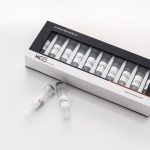Filters Sort results
Reset Apply
Carcinoembryonic antigen (CEA) exists on the surface of cancer cells differentiated from endoderm cells. Carcinoembryonic antigen is a broad-spectrum tumor marker, elevated in colorectal cancer, gastric cancer, lung cancer, pancreatic cancer, breast cancer, ovarian cancer, uterine and cervical cancer [1]. HKIG offers 2 monoclonal antibodies (catalog numbers: 1017101 and 1017201) for CEA detection. Anti CEA … Carcinoembryonic Antigen (CEA)">Continue reading Carcinoembryonic Antigen (CEA) | ||
Prostate Specific Antigen (PSA) is a single-chain glycoprotein secreted by prostate epithelial cells, which belongs to the kininase family, and exists in prostate tissue and semen. PSA can be present alone in free form (fPSA) or in a bound state (cPSA) by binding to α1-antichymotrypsin or α2-macroglobulin. The free form and bound form of PSA … Free Prostate-Specific Antigen (fPSA)">Continue reading Free Prostate-Specific Antigen (fPSA) | ||
Diagnostic markers for AD, Mammalian cells (CHO) recombinant expression | ||
Human epididymal protein 4 (HE4) was first discovered in human distal epididymal epithelial cells. Human epididymal protein 4 and CA125 levels have a strong correlation in the diagnosis and treatment of ovarian cancer patients, and serum HE4 levels can be used as tumor markers to evaluate the efficacy of ovarian cancer treatment [1]. HKIG currently … Human Epididymal Protein 4 (HE4)">Continue reading Human Epididymal Protein 4 (HE4) | ||
Diagnostic markers for AD, Mammalian cells (CHO) recombinant expression | ||
Pepsinogen (PG) is a single-chain polypeptide composed of 375 amino acids that belongs to the aspartate protein family. Human pepsinogen can be divided into seven isoenzymes, of which pg1-pg5 has common immunogenicity, known as PG I; pg6 to pg7 has a slower migration rate and is called PG II. The change of serum PG level … Pepsinogen I">Continue reading Pepsinogen I |


